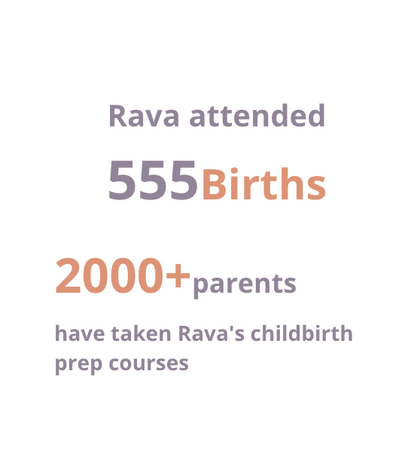Rava Womb Birth Prep Course
Rava Womb's signature self-paced 100% online course that you take from the comfort of your home!
Enjoy the freedom of learning at your own pace and when it's convenient for your schedules.
The knowledge, tools, practices and guidance are delivered in 5 ways:
1. Video: Rava teaching with incredible slides, images, video and illustrations (not a lot of birth videos and if you don't feel ready to see any video of birth yet, just skip ahead)
2. Audio: some lessons are delivered via audio, but the majority of them are video. All of the hypnosis and meditation training for your mind is delivered via audio
3. Some written material to read and helpful worksheets you can download
4. For the birth partners supporting: this course is packed with multiple cheat sheets for you!
5. This course is anchored in research and evidence-based practices in childbirth. Therefore you'll find many links to additional information if you want to read more; and links to recommended birth videos.
How do you access the course?
Access is granted to the RavaWomb learning portal - we give you a username and password. There you will find all your modules and lessons.
And you have the choice of accessing the Rava Womb portal from your browser or in our app.
What's included?
There are 13 modules. Keep scrolling to see what the modules are, and for links to the curriculum and a deeper description of each.
Enroll Now
You've Got Options
$166
over 3 payments
MOST POPULAR
$222
over 2 payments
GET THE BONUSES
Pay In Full and
Get These Bonuses ⬇️
BONUSES - VALUE: $855
• Live Q & A + Coaching 1 : 1 Session with Rava Burke (value: $150)
• Lifetime Membership in the Rava Womb parents group (value: $500)
• Recorded Birthing Affirmations: listen to them over and over in your pregnancy and be soothed by Rava's calming voice (value: $75)
• Extra Cheat Sheets for Supporting Partner (value: $65)
• Guides for pregnancy, birth & postpartum (value: $65)
• Communication Guidance: this is so essential to have with your partner. Value: priceless - let's keep your relationship on track after your baby arrives!
Are you thrilled about your baby, but have fears, concerns and questions about birth, parenting or postpartum?
Going in blindly, and just hoping for the best, almost always results in suffering, struggle and often even birth trauma. Instead, we can help you gain priceless confidence in yourself!

You'll be ready. We promise. You just need some support to get there
Learn from one of the most experienced doulas and childbirth educators Rava Burke, who has prepared 2000+ couples for childbirth
Want to know more about her? >> Rava

Induction / Augmentation
of Labor

The Golden Hour

The Path of Labor

Maps of the Birth Journey
Water Wisdom
How to labor using water
How to have a waterbirth



Guided Meditation and Hypnosis for Childbirth

Coping in the Childbirth Year
Coping methods for your Pregnancy,
Labor and early Postpartum
When giving birth to your baby via cesarean birth (either unplanned or scheduled) there is much you can do to prepare yourself in advance.
What to Expect and Coping
Learn about coping during the surgery. Because c-section surgery is not 100% free of sensation. Quite the opposite. When you give birth by cesarean there will be a lot for you and your partner to cope with.
Choices in Cesarean Birth
Think your birth plan goes out the window when you find out you are having a c-section to birth your baby? Nope. There are still many many options that maybe you don't know you have. Find out what they are and the tricks to advocate (successfully) for what you want.
Did you know that monitoring your baby's heart rate when you are in labor is one of the most important & primary ways that your midwife or doctor monitors the well-being of your baby?
Did you know that there a few ways this can be done, and that you do have options to choose from?
You may have a preference and you could include this in your birth plan. It's good to be educated about when a certain option might be more ideal than another. Learn all the consequences of each choice.

>> Partners: learn how to manually use specific techniques in certain areas (using your hands, legs, tools etc.). What these techniques are, and how to do them correctly and effectively. These aren't massage techniques - massage is what is called a "comfort measure". These techniques are the beast!
>> These techniques reduce labor sensations and pain she is experiencing by as much as 50% and when combined with other practices, the discomfort, pain, intensity can be reduced even more. All by you knowing what to do and how to do it - good news right? Be a rockstar in the birthspace!
>> When to call, who to call, when to leave for your birthing place (if not birthing at home); how to time uterine contractions (it's not what you might think). The best apps for this (some are crap) and what settings you want on the app. And much more about this crucial part of your role.
>> Learn the common pitfalls to avoid when supporting your partner in labor (it's not what you might think).
>> Learn what tools and "stuff" that you need most for the labor —and how to use these tools.
>> Learn what items you do not need. This is especially important when birthing at hospital or birth center - so you don't end up bringing in four suitcases. Not very practical. And not necessary.

Coping methods for your Pregnancy, Labor and early Postpartum
>> This in-depth module gives you numerous coping techniques you can use in labor.
>>These are the non-drug methods; the pharmacological options are covered in another module. What if I think I might get an epidural? There's definitely an early phase of labor that you need to get through until the timing is right for an epidural. And these are the techniques you need to learn so you can cope during this early labor phase (and all phases, even if you end up having a cesarean birth!)
>> Techniques and practices that aren't just for labor! So that means you can use them now in your pregnancy for any discomfort or stress you might be experiencing. You can also use them in your postpartum period. Many RavaWomb clients write in reviews about how they've used them for the rest of their lives - they are that valuable.
>> As part of coping in labor it's important to know (especially for partners) what is happening and what are the best coping practices to match with what labor moments. So this course includes modules on what happens in labor and how labor progresses. This course works well taken with Maps of the Birth Journey.
Guided Meditation and Hypnosis for Childbirth
Calm your nerves, alleviate stress and regulate your nervous system right now during your pregnancy and when you are in labor.
Listen to these audio tracks NOW to:
>> sleep better all through your pregnancy
>> create a deep sense of calm
>> dissolve the stress you are feeling
>> give you relaxation and rest and rejuvenation for your mind, body and spirit
>> build the mindset you need for giving birth
>> help prepare you for the arrival of your new baby
>> set the foundation so your mind is receptive to using these same techniques for the birth
>> develop your ability to remain calm and focused - no matter what's happening in your body or around you
>> discover that with support it is possible to have negative thoughts drift away, and be replaced with that powerful positive mind-set that is more helpful to your pregnancy and to your birth and postpartum experience
This training is a combination of guided meditation, hypnosis and relaxation.
No doubt you have noticed there's a lot going on for you! All the changes within your body as well as so much preparation to do. And thoughts of "How am I going to actually birth this baby?" and "What do I need to know?" and "What can help me to be ready for this?"
These can be stressful thoughts so this program melts all that stress away at the end of a long day of working and growing your baby within you.

Mindset for Birth
How do you truly prepare for birth? Comfort measures, yes, but those will not be enough.
Train to gain the mindset and skills that will truly help you when you are in labor, and yes even if you plan to have an epidural.

Birth Partner Training
Are you afraid of labor pain?
Uncertain about what childbirth really feels like?
Anxious that it might be the most pain you've ever experienced?
Of course you're believing that—it's what western culture has conditioned us to think. That birth is the worst pain in the world.
When birth happens in movies and tv shows that's the script —because drama sells. If birth were portrayed realistically, intense but manageable, it would be boring television!
Here's the truth: it's not the worst pain a human can feel. Women who have experienced both childbirth and kidney stones consistently report that kidney stones were far more painful than giving birth.
Do you sometimes think you just don't know how you'll cope with labor without an epidural?
You've likely heard that epidurals can be helpful, and many women have shared positive experiences. But you might be surprised to learn that timing matters! Because proper timing can prevent negative consequences.
Getting the timing right is an ideal approach if getting an epidural: so that it doesn't affect your labor.
Don't believe that 100% of the time getting an epidural leads to the need for Pitocin (the artificial hormone used to keep contractions going). Or that it always leads to cesarean. The truth is Pitocin and Cesarean do become statistically more likely when an epidural is part of birth.
What isn't talked about though is this good news: you can reduce your chances of needing a c-section or having your labor augmented by managing many factors in epidural use. In Rava Womb Birth Prep you learn exactly how to do this.
Are you worried about getting to the hospital too soon? Arriving at Labor and Delivery and told you're there "too early" and being sent home?
Or maybe you've heard the longer you are there the more interventions they'll want to do (sadly, this is true).
It is true that they don't accept mothers into the L & D unit until you're at a certain stage in labor. For most hospitals this is when a woman's cervix is open to 6 cm (for 1st baby). There's a new saying these days: "6 is the new 4". Because it used to be - even with your 1st labor - you'd be admitted at 4 cm. Now it's 6 cm. For 2nd and subsequent babies it's 4 cm.
So if an epidural is part of your coping plan, just know you cannot get one at 1 cm dilation. And you wouldn't want to!! Because having an epidural that early has very negative consequences on how your labor will unfold. In the shortest phrase possible: "epidurals really mess with labor!" But these effects can be mitigated.
These hospital policies mean getting an epidural early in labor is not an option so this means thinking about how to cope up until then. Rava Womb Birth Prep teaches you so many coping practices so that you will be able to cope (up to 6cm—1st labor; up to 4 cm—2nd+ labors).
If you are having any of those thoughts, then it's likely you don't yet have what you need to give birth to your baby without fear.
And these thoughts aren't unique to you. Many (most) expectant mothers have these thoughts.
In our Western culture we've been taught to fear the pain of childbirth and told that birth is terrible! The worst pain a human can feel!
It's no wonder you might be having these thoughts!
Limited time offer of
$725
value
$725
$417
Get your Birth Prep Course now
It's never too early - anytime after 20 weeks is a good time to start
The section Sharing couldn't be migrated automatically. If any text was found, it is included below, followed by the rest of the settings.
Sign Up
send your info and you'll be enrolled and we'll send you an order form
© RavaWomb 2024






